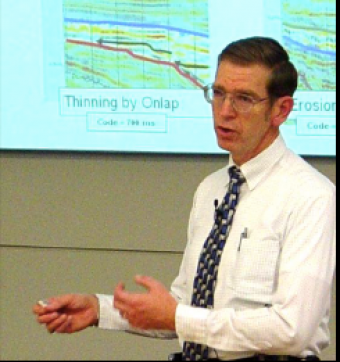This lesson is an overview of seismic data processing. Seismic data acquisition and seismic data processing work together to produce the best earth image. Ideally, processed seismic data should represent the true earth response. In practice, however, the processed data will only be an approximation. The challenge is to estimate and remove the effects of non-geologic signals, without impacting the amplitude and phase of the primary reflections.
The lesson should be divided into four (4) segements, a review of the previous exercise (Exercise 16), the lecture material for this lesson, and then introuduce the two (2) exercises - Exercises Part A and B. The review of the previous exercise (Exercise 16) has three (3) slides, and will take ~8 minutes to explain. The lecture material contains sixty (60) slides, and takes ~90 minutes to explain. For classes with a geophysics focus, you may want to spend two (2) class periods covering this. Otherwise, you may want to cut this down to twenty (20) or so slides to cover this all in one class period. Or, you may choose to skip this altogether.
The introduction to Exercise Part A contains four (4) slides, and will take ~5 minutes to explain. The introduction to Exercise Part B contains two (2) slides, and takes ~7 minutes to explain. The class materical will take ~110 minutes to cover.
In Part A of the exercise, students will consider how the top of an anticline would appear on a seismic line prior to performing a seismic migration processing step. The process is essentially the same as what is illustrated for a dipping sea floor in the lecture. Thus, the exercise instructions are easy to follow, especially after you show how to handle shot 1 and shot 2 in the introduction. It should not take more than ~10 minutes for students to complete the exercise.
In Part B of the exercise, students will evaluate processing results and select which of six (6) processing streams they would choose for interpretation. This is a “beauty pageant” that is quite subjective. There are three (3) criteria to use, which are given in the introduction. This exercise could be quite hard for the students. Tell them to use a process of elimination. The students should work on it for NO MORE THAN 15 MINUTES. They should be able to eliminate a few of the six (6) choices. It is OK if they cannot get it down to a single choice. The solution will go over the process of elimination that I used to come up with my choice for the best. Students should work no more than ~15 minutes on this exercise.
After this lecture, the student should be able to:

This course, based on teaching material from Dr. Fred Schroeder (formerly of Exxon/ExxonMobil), reflects on the geology and geophysics basics for the petroleum industry. General geology and basic geophysics are not required, but helpful with the material.
We encourage the reuse and dissemination of the material on this site as long as attribution is retained. To this end the material on this site, unless otherwise noted, is offered under Creative Commons Attribution (CC BY 4.0) license